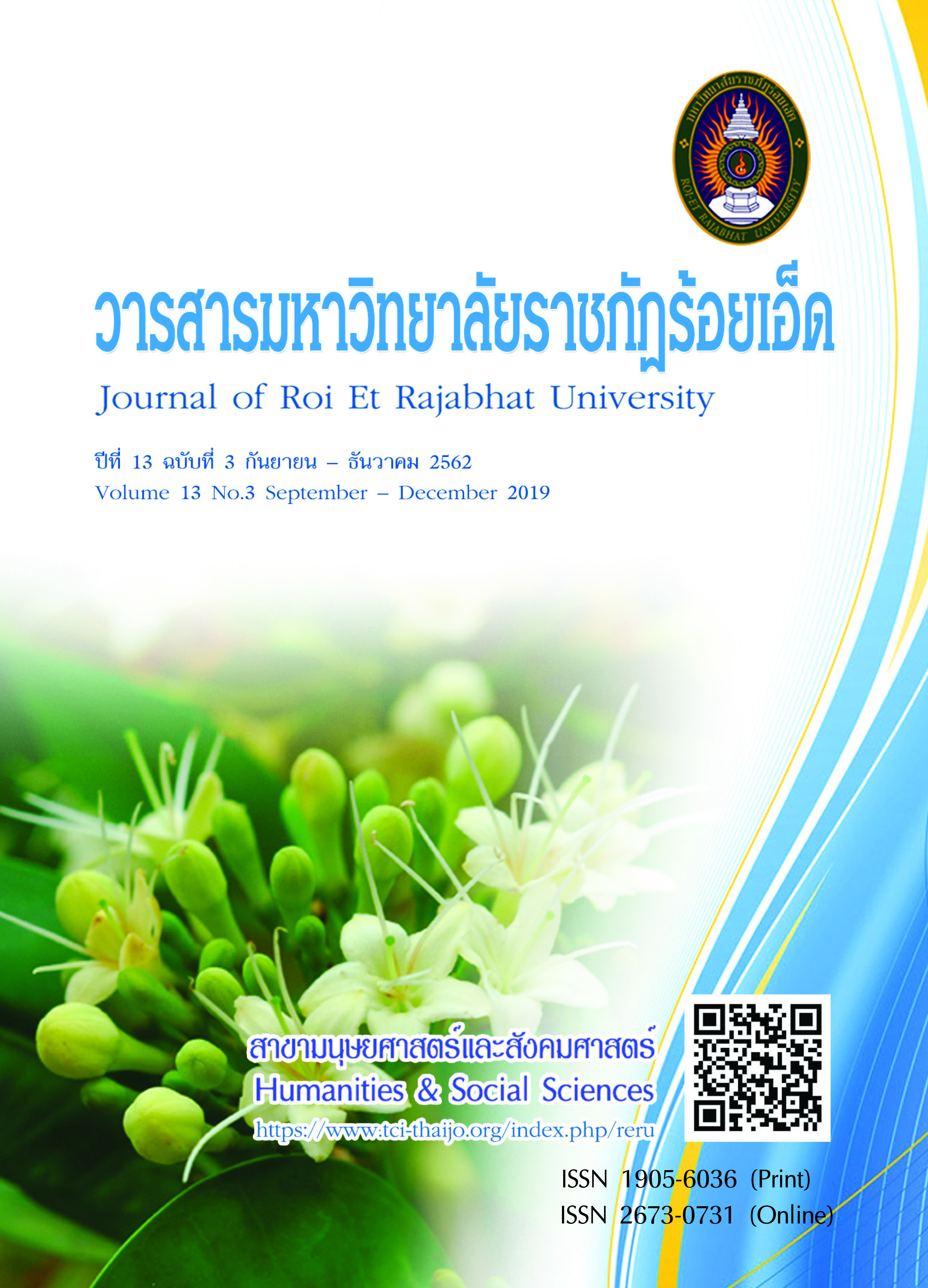The Development of Creative Leadership Indicators of Primary School Directors under Primary Educational Service Area Offices in Sakon Nakhon Province
Keywords:
Leadership, Creative Leadership, Indicators developmentAbstract
The objectives of this study were to develop creative leadership indicators of primary school directors and to examine the congruence between the developed structural model on creative leadership indicators of primary school directors and the empirical data. The study was divided into 2 phases. The first phase was the development of creative leadership indicators of primary school directors by analyzing relevant documents and researches, while the second phase was the examination of congruence between the developed structural model on creative leadership indicators of primary school directors and the empirical data by confirmatory factor analysis. The sample group consisted of 435 primary school directors who were selected through multi-stage sampling. Data were analyzed by using statistics software and collected by the employment of 5-level rating scale questionnaire with content validity between 0.60-1.00, discrimination value between 0.46-0.91 and overall reliability value, calculated by Cronbach's alpha coefficient, at 0.99. Used statistics for data analysis involved: mean, standard deviation, chi-square, goodness of fit Index (GFI), adjusted goodness of fit Index (AGFI), root mean square error of approximation (RMSEA), and critical N. Research results showed that creative leadership indicators of primary school directors comprise 4 main components, 15 sub-components and 65 indicators. The four components of creative leadership included: flexibility with 9 indicators; creativity with 16 indicators; imagination with 19 indicators, and vision with 22 indicators. The developed structural model on creative leadership indicators of primary school directors showed congruence with the empirical data, (2 =25.96, df=24, p=0.35, GFI=0.99, AGFI=0.96, RMSEA=0.01, CN=702.19). The factor loading of 65 indicators were between 0.45-1.00.
References
สืบค้นเมื่อ 1 เมษายน 2561, จาก https://data.bopp-obec.info/emis/school_web.php?Area_CODE=4701
กลุ่มสารสนเทศ สำนักงานเขตพื้นที่การศึกษาประถมศึกษาสกลนคร เขต 2. (2561). ระบบสารสนเทศเพื่อการศึกษา.
สืบค้นเมื่อ 1 เมษายน 2561, จาก https://data.bopp-obec.info/emis/index_area.php?Area_CODE=4702
กลุ่มสารสนเทศ สำนักงานเขตพื้นที่การศึกษาประถมศึกษาสกลนคร เขต 3. (2561). ระบบสารสนเทศเพื่อการศึกษา.
สืบค้นเมื่อ 1 เมษายน 2561, จาก https://data.bopp-obec.info/emis/index_area. php?Area_CODE=4703
กัลวัฒน์ มัญชะสิงห์. (2554). การิเคราะห์สหสัมพันธ์ (Correlation Analysis). สืบค้นเมื่อ 1 เมษายน 2561,
จาก https://kalawat.esu.ac.th/joomla1522/index.php/component/content/article/44-resarch/83-
correlation-analysis.
กิตติ์กาญจน์ ปฏิพันธ์. (2555). โมเดลสมการโครงสร้างภาวะผู้นำเชิงสร้างสรรค์ของผู้บริหารสถานศึกษาอาชีวศึกษา.
ดุษฎีนิพนธ์ ปรัชญาดุษฎีบัณฑิต สาขาวิชาการบริหารการศึกษา. ขอนแก่น: มหาวิทยาลัยขอนแก่น.
ไกศิษฏ์ เปลรินทร์. (2552). การพัฒนาตัวบ่งชี้ภาวะผู้นำทางวิชาการสำหรับผู้บริหารสถานศึกษา. ดุษฎีนิพนธ์
ศึกษาศาสตรดุษฎีบัณฑิต สาขาวิชาการบริหารการศึกษา. ขอนแก่น: มหาวิทยาลัยขอนแก่น.
ธีระ รุญเจริญ. (2553). ความเป็นมืออาชีพในการจัดและบริหารการศึกษา: ยุคปฏิรูปการศึกษา (ฉบับปรับปรุง) เพื่อปฏิรูป
รอบ 2 และการประเมินภายนอกรอบ 3 (พิมพ์ครั้งที่ 2). กรุงเทพฯ: ข้าวฟ่าง.
นงลักษณ์ วิรัชชัย. (2551). การพัฒนาตัวบ่งชี้การประเมิน. การประชุมวิชาการ เปิดขอบฟ้าคุณธรรมจริยธรรม ครั้งที่ 1.
29 สิงหาคม 2551. ฌ โรงแรมแอมบาสเดอร์: 8-15.
ประยูร เจริญสุข. (2553). การพัฒนาตัวบ่งชี้งานวิชาการสำหรับสถานศึกษาขั้นพื้นฐาน. ดุษฎีนิพนธ์ ศึกษาศาสตรดุษฎีบัณฑิต
สาขาวิชาการบริหารการศึกษา. ขอนแก่น: มหาวิทยาลัยขอนแก่น.
เริงชัย ตันสุชาติ. (2548). เศรษฐมิติ= Econometrics. เชียงใหม่: โรงพิมพ์โทนคัลเลอร์.
วิมล จันทร์แก้ว. (2555). รูปแบบการพัฒนาภาวะผู้นำเชิงสร้างสรรค์ของผู้บริหารสถานศึกษา สังกัดสำนักงานเขตพื้นที่การศึกษา
ประถมศึกษาสุราษฎร์ธานี เขต 3. ดุษฎีนิพนธ์ ศึกษาศาสตรดุษฎีบัณฑิต สาขาวิชาการศึกษา. กรุงเทพฯ:
มหาวิทยาลัยรังสิต.
สมชาย รุ่งเรือง และ ธีระวัฒน์ จันทึก. (2560). รูปแบบการพัฒนาผู้นำสู่การสร้างแรงผลักดันเชิงสร้างสรรค์. Verdian E-Journal,
Silpakorn University, 10(1), 29-46.
สำนักงานเลขาธิการสภาการศึกษา. (2550). รายงานการวิจัยผลกระทบโลกาภิวัตน์ต่อการจัดการศึกษาไทยใน 5 ปี ข้างหน้า.
กรุงเทพฯ: บริษัทออฟเซทเพรส จำกัด.
สำนักงานเลขาธิการสภาการศึกษา. (2555). จะปฏิรูปการศึกษาให้เกิดผลจริงได้อย่างไร. รายงานเรื่องภาวะการศึกษาไทย
ปี 2552-2553 (พิมพ์ครั้งที่ 2). กรุงเทพฯ: สำนักงานวิจัยและพัฒนาการศึกษากระทรวงศึกษาธิการ.
สุขพัชรา ซิ้มเจริญ. (2556). โครงสร้างองค์ประกอบภาวะผู้นำเชิงสร้างสรรค์ของผู้นิเทศภายในสถานศึกษาระดับมัธยมศึกษา
สังกัดสำนักงานคณะกรรมการการศึกษาขั้นพื้นฐาน. ดุษฎีนิพนธ์ ปรัชญาดุษฎีบัณฑิต สาขาวิชาบริหารการศึกษา.
กรุงเทพฯ: มหาวิทยาลัยศรีปทุม.
อาภารัตน์ ราชพัฒน์. (2554). การพัฒนาตัวบ่งชี้ภาวะผู้นำของครูในสถานศึกษาขั้นพื้นฐาน. ดุษฎีนิพนธ์ ปรัชญาดุษฎีบัณฑิต
สาขาวิชาการบริหารการศึกษา. ขอนแก่น: มหาวิทยาลัยขอนแก่น.
Downloads
Published
How to Cite
Issue
Section
License
บทความที่ได้รับการตีพิมพ์เป็นลิขสิทธิ์ของวารสารมหาวิทยาลัยราชภัฎร้อยเอ็ด
ข้อความที่ปรากฏในบทความแต่ละเรื่องในวารสารวิชาการเล่มนี้เป็นความคิดเห็นส่วนตัวของผู้เขียนแต่ละท่านไม่เกี่ยวข้องกับมหาวิทยาลัยราชภัฎร้อยเอ็ด และคณาจารย์ท่านอื่นๆในมหาวิทยาลัยฯ แต่อย่างใด ความรับผิดชอบองค์ประกอบทั้งหมดของบทความแต่ละเรื่องเป็นของผู้เขียนแต่ละท่าน หากมีความผิดพลาดใดๆ ผู้เขียนแต่ละท่านจะรับผิดชอบบทความของตนเองแต่ผู้เดียว





